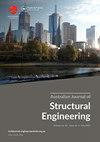椰壳粗骨料自重自密实混凝土抗压强度与弹性模量的关系
IF 1.3
Q4 ENGINEERING, CIVIL
Australian Journal of Structural Engineering
Pub Date : 2021-04-03
DOI:10.1080/13287982.2021.1926061
引用次数: 5
摘要
集料是制造混凝土的基本成分。由于对天然岩石的过度开采,混凝土中骨料需求的增加正在影响环境。为了保护自然资源和尽量减少工业副产品对环境的不利影响,探索合适的替代建筑材料至关重要。在这种情况下,尝试用椰子壳骨料(CSA)代替常规粗骨料(CA)在自密实混凝土(SCC)中应用。本研究采用稻壳灰(RHA)和硅灰(SF)等矿物外加剂,研制了二元和三元混合SCC。设计了总粉量分别为450和550 kg/m3的两个系列的SCC进行研究。研究了SCC中添加CSA对其新鲜和硬化性能的影响,并与未添加CSA的结果进行了比较。结果表明,在SCC中使用75%的CSA,在干燥状态下,密度降低到结构轻量化混凝土的阈值水平(1850 kg/m3)以下。csa基轻质自密实混凝土在新鲜状态下具有良好的流动性、变形性、通过性和填充性。测定了LWSCC的抗压强度和弹性模量,发现CSA替代量超过75%后,结果有所下降。此外,本文旨在预测基于csa的LWSCC的抗压强度与弹性模量之间的适当相关性。本文章由计算机程序翻译,如有差异,请以英文原文为准。
Correlation between compressive strength and elastic modulus of light weight self-compacting concrete using coconut shell as coarse aggregate
ABSTRACT Aggregates are the fundamental ingredient for making concrete. The incremental demand for aggregates in concrete is affecting the environment due to excessive exploitation of natural rocks. In an effort to conserve the natural resources and minimise the adverse impacts of industrial by-products in the environment, it is essential to explore the suitable alternate materials for construction. Under such circumstances, an attempt was made with coconut shell aggregate (CSA) as a substitute for conventional coarse aggregate (CA) in self-compacting concrete (SCC). In this investigation, binary and ternary blended SCC were developed using the mineral admixtures such as rice husk ash (RHA) and silica fume (SF). Two series of SCC were designed with the total powder content of 450 and 550 kg/m3 , respectively, for investigation. The effects of CSA in SCC on fresh and hardened properties were studied and compared with the results obtained without CSA. The results revealed that use of 75% CSA in SCC reduced the density below the threshold level of structural lightweight concrete (1850 kg/m3) in dry state. The CSA-based lightweight self-compacting concrete (LWSCC) possesses good fluidity, deformability, passing ability and filling ability in its fresh state. The compressive strength and elastic modulus of LWSCC were determined and found that the results are decreased after the substitution of more than 75% of CSA. Further, the paper intended to predict an appropriate correlation between compressive strength and elastic modulus of CSA-based LWSCC.
求助全文
通过发布文献求助,成功后即可免费获取论文全文。
去求助
来源期刊

Australian Journal of Structural Engineering
ENGINEERING, CIVIL-
CiteScore
2.50
自引率
0.00%
发文量
31
期刊介绍:
The Australian Journal of Structural Engineering (AJSE) is published under the auspices of the Structural College Board of Engineers Australia. It fulfils part of the Board''s mission for Continuing Professional Development. The journal also offers a means for exchange and interaction of scientific and professional issues and technical developments. The journal is open to members and non-members of Engineers Australia. Original papers on research and development (Technical Papers) and professional matters and achievements (Professional Papers) in all areas relevant to the science, art and practice of structural engineering are considered for possible publication. All papers and technical notes are peer-reviewed. The fundamental criterion for acceptance for publication is the intellectual and professional value of the contribution. Occasionally, papers previously published in essentially the same form elsewhere may be considered for publication. In this case acknowledgement to prior publication must be included in a footnote on page one of the manuscript. These papers are peer-reviewed as new submissions. The length of acceptable contributions typically should not exceed 4,000 to 5,000 word equivalents. Longer manuscripts may be considered at the discretion of the Editor. Technical Notes typically should not exceed about 1,000 word equivalents. Discussions on a Paper or Note published in the AJSE are welcomed. Discussions must address significant matters related to the content of a Paper or Technical Note and may include supplementary and critical comments and questions regarding content.
 求助内容:
求助内容: 应助结果提醒方式:
应助结果提醒方式:


